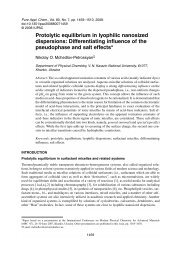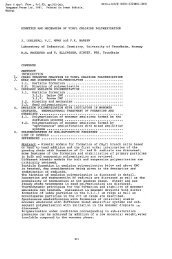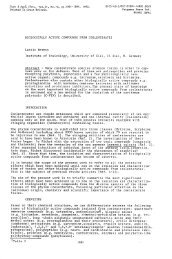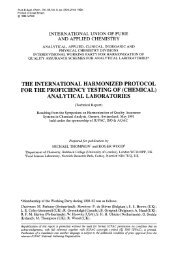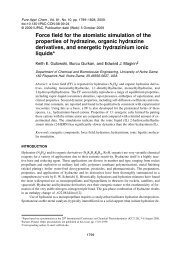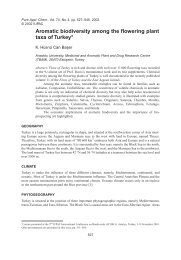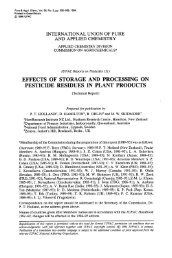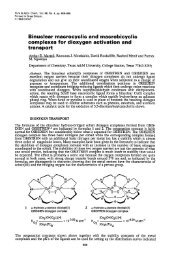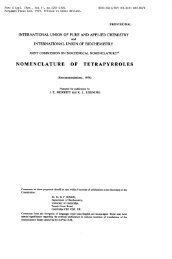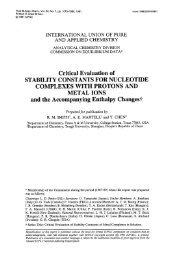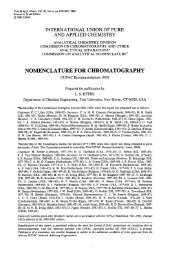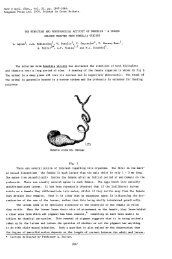MEASUREMENT OF CELLULASE ACTIVITIES - IUPAC
MEASUREMENT OF CELLULASE ACTIVITIES - IUPAC
MEASUREMENT OF CELLULASE ACTIVITIES - IUPAC
Create successful ePaper yourself
Turn your PDF publications into a flip-book with our unique Google optimized e-Paper software.
Pure & App!. Chem., Vol. 59, No. 2, pp. 257—268, 1987.<br />
Printed in Great Britain.<br />
© 1987 <strong>IUPAC</strong><br />
INTERNATIONAL UNION <strong>OF</strong> PURE<br />
AND APPLIED CHEMISTRY<br />
APPLIED CHEMISTRY DIVISION<br />
COMMISSION ON BIOTECHNOLOGY*<br />
<strong>MEASUREMENT</strong> <strong>OF</strong><br />
<strong>CELLULASE</strong> <strong>ACTIVITIES</strong><br />
Prepared for publication by<br />
T. K. GHOSE<br />
Biochemical Engineering Research Centre,<br />
Indian Institute of Technology, New Delhi-110016, India<br />
*Membership of the Commission during the preparation of the report (1981—1985) was as<br />
follows:<br />
Chairman: 1981—83 H. Deliweg (FRG); 1983—85 C. L. Cooney (USA); Vice-Chairman: 1981—83<br />
C. L. Cooney (USA); 1983—85 M. Ringpfeil (GDR); Secretary: 1981—83 R. C. Righelato (UK);<br />
1983—85 G. G. Stewart (Canada); Titular and Associate Members: H. T. Blachère (France;<br />
Titular 1981—83); V. K. Eroshin (USSR; Associate 1981—83); A. Fiechter (Switzerland; Associate<br />
1981—83); T. K. Ghose (India; Titular 1981—85); P. P. Gray (Australia; Associate 1983—85);<br />
J. Holló (Hungary; Titular 1981—83); A. E. Humphrey (USA; Associate 1981—83); M. Linko<br />
(Finland; Associate 1983—85); R. C. Righelato (UK; Associate 1983—85); G. G. Stewart<br />
(Canada; Associate 1981—83); J. Takahashi (Japan; Titular 1981—83); J. E. Zajic (USA;<br />
Associate 1981—83); National Representatives: R. J. Ertola (Argentina; 1981—85); P. P. Gray<br />
(Australia; 1981—83); H. J. G. Wutzel (Austria; 1981—85); W. Borzani (Brazil; 1981—85);<br />
M. Moo-Young (Canada; 1983—85); B. Sikyta (Czechoslovakia; 1981—85); K. Von Meyenburg<br />
(Denmark; 1981—85); H. Dellweg (FRG; 1983—85); M. Linko (Finland; 1981—83); L. Penasse<br />
(France; 1983—85); M. Ringpfeil (GDR; 1981—83); J. Holló (Hungary; 1983—85); V. Jagannathan<br />
(India; 1983—85); L. Goldstein (Israel; 1983—85); F. Parisi (Italy; 1983—85); S. Fukui (Japan;<br />
1981—85); B. G. Yeoch (Malaysia; 1983—85); 0. Ilnicka-Olejiniczak (Poland; 1981—83); E. Galas<br />
(Poland; 1983—85); A. Fiechter (Switzerland; 1983—85); V. Johanides (Yugoslavia; 1981—85).<br />
Republication of this report is permitted without the need for formal <strong>IUPAC</strong> permission on condition that an<br />
acknowledgement, with full reference together with <strong>IUPAC</strong> copyright symbol (© 1987 <strong>IUPAC</strong>), is printed.<br />
Publication of a translation into another language is subject to the additional condition of prior approval from the<br />
relevant JUPAC NationalAdhering Organization.
Measurement of cellulase activities<br />
Fermentation Commission, <strong>IUPAC</strong>, (changed to Commission on Biotechnology,<br />
JUPAC, July 1980) put in a considerable effort and time since July 1976 to prepare<br />
a document prescribing standard assay procedures for cellulase enzyme system.<br />
The subject area was considered significantly important because the number of<br />
groups engaged in the studies of enzymatic break-down of cellulose of various<br />
sources were on steady increase. At least nine Commission meetings held during<br />
the last several years (Berlin, July 1976; Warsaw, June 1977; Munich, Sept. 1978;<br />
Davos, Sept. 1979; London (Ontario), July 1980; Leuven, Aug. 1981; MIT<br />
(Boston), Aug. 1982; Lyngby, Aug. 1983 & New Delhi,Feb.1984) gave considerable<br />
attention to this project. Several aspects of the proposed standard procedures<br />
available to workers for enzyme and substrate evaluation were considered.<br />
The detailed text of the draft prepared during mid 1980 and partially modified in<br />
early 1982 were discussed by the Commission at the MIT workshop in 1982. At<br />
the Lyngby meeting the Commission gave its final recommendations on the manuscript<br />
which after some additional review was adopted at the New Delhi meeting<br />
in February 1984 for release. Several procedures were suggested in the draft for<br />
consideration of the members of the Commission and other experts in the field.<br />
Thefinal version of the Commission's draft is expected to be useful as a document<br />
of standard procedures for assay and evaluation of cellulase enzyme system.<br />
Although for a subject area so complicated and involved like the assay procedures<br />
of various enzymes associated with cellulose-cellulase system, it was expected<br />
that the concerned groups and individuals might find it difficult to agree to<br />
a commoff draft. However, the members of the Commission as well as others who<br />
collaborated in the preparation of the document felt the need for a working<br />
document to form the basis of exchange of ideas and comparison of results. With<br />
this in view the New Delhi meeting of the Commission finally approved the<br />
recommendations for circulation. Necessarily, the Commission will review the<br />
assay procedures as and when some new information is available.<br />
Contents<br />
Preface<br />
I. Introduction<br />
H. General Information<br />
III. Folin Protein Determination<br />
IV. Cellobiase Assay<br />
V. Filter Paper Assay for Saccharifying Cellulase<br />
VI. Carboxymethyl Ceilulase Assay for Endo-3-l, 4-glucanase<br />
VII. Additional Assay Procedure for Endoglucanase<br />
VIII. Evaluation of Cellulase under Process Conditions<br />
IX. General Remarks<br />
References<br />
International Collaborators<br />
I. INTRODUCTION<br />
The characterization of cellulase enzymes poses special problems to the enzymologist, which are rarely<br />
encountered in the study of other enzymes. He is presented with a situation where kinetic studies are<br />
difficult since the natural substrate is both insoluble and structurally variable, and thus relatively undefined<br />
with respect to concentration and chemical form; where often a .multitude of endo- and exoglucanases<br />
act in synergy and in a complex manner still poorly understood; 'and where a variety of<br />
end-products and transglycosylation species are frequently formed, involving various mechanisms of<br />
feedback control. The presence of /3-glucosidase or other enzymes, such as cellobiose phosphorylase,<br />
which are required for cellobiose metabolism and to enhance cellulose hydrolysis but which are not,<br />
strictly speaking, cellulases, further complicates the picture. Moreover, there has been comparatively<br />
little elucidation of the differences in the modes of action of the cellulase system of various organisms, and<br />
especially between eucaryotes and procaryotes.<br />
258
Measurement of cellulase activities 259<br />
In the face of these difficulties, and in view of the applied nature of most cellulase work, it is understandable<br />
that investigators in different laboratories have each developed a series of empirical assay procedures.<br />
While a common approach is shared, a situation has nonetheless resulted where comparison of<br />
cellulaseactivities between laboratories is not readily made in a quantitative manner. These recommendations<br />
for standard assays are intended to alleviate to some extent the present lack of uniform procedures<br />
with, however, certain reservations.<br />
First, these procedures have received common acceptance primarily for the evaluation of the cellulase<br />
system of Trichoderma, and possibly other mesophilic fungal species. Studies with cellulolytic bacteria,<br />
such as Clostridium thermocellum or Thermomonospora fusca, suggest that these cellulase systems may<br />
have a different mode of action. Moreover, pH and temperature conditions for optimal cellulase activity<br />
from these organisms are different than those for most fungi. Thus, the assay procedures will often need to<br />
be adapted to other cellulase systems by linearizing with respect to time, substrate and enzyme concentration,<br />
and by proper specification of pH and temperature. However, the criteria of assaying FPA employing<br />
filter paper as insoluble substrate must be based on equal conversion (in the present recommendations—4%)<br />
since the rates are not likely to be linear and representative of true filter paper activity<br />
(see Section II. General Information).<br />
Second, the specific assays which have been recommended are not meant to be inclusive, but were chosen<br />
on the basis of common usage and procedural ease. Other assays in the literature will undoubtedly<br />
continue to find limited application. Some notable examples are:<br />
(1) viscosimetric assay' using soluble, derivatized cellulose, which is a very sensitive, but somewhat<br />
difficult method of measuring endoglucanase (EC 3.2.1.4) activity;<br />
(2) cellulose azure assay2 using laboratory prepared or commercially available dyed cellulose, a convenient<br />
method of measuring primarily cellobiohydrolase (EC 3.2. 1 .91) activity by dye release; and<br />
(3) filter paper degrading (FPD) assay3, a simple, useful, but somewhat time consuming method, requiring<br />
no sophisticated equipment.<br />
Some investigators prefer to use alternative substrates, e.g. microcrystalline cellulose in the form of<br />
Avicel instead of filter paper, or different forms of soluble substituted cellulose. Where these alternative<br />
procedures appear to be justified, their use will undoubtedly continue. Again, the empirical nature of the<br />
recommended assays will more likely be of continued value to biotechnologists thanto enzymologists, who<br />
will find these methods lacking in theoretical definition. The need yet remains to develop accurately<br />
defined cellulosic substiates for precise assay procedures.<br />
It is well known that the level of f3-glucosidase in an enzyme preparation may affect the result of cellulase<br />
assays, in particular the assay of FPA4. In order to overcome this problem, it would be important in the<br />
future either to modify the FPU assay of Mandels et a!. , or else to adopt a method which is not affected by<br />
the level of fJ-glucosidase in the enzyme preparation. One such method is the Dyed Avicel method of<br />
Leisola and Linko2, which was not, however, adopted in the present recommendations. Modfication of<br />
the FPU assay would involve either addition of excess fJ-glucosidase so that all of the product of the<br />
cellulolytic enzyme (s) would be measured as glucose or alternatively removal or inhibition of the /3glucosidase<br />
component of the cellulase enzyme so that the reaction product measured would be produced<br />
solely by the action of the truly cellulolytic enzyme (s).<br />
Finally it must be remembered that assay activities may not reflect potential saccharification performance.<br />
Other considerations become of great importance to commercial cellulose hydrolysis, such as end-product<br />
inhibition, the addition of cellobiase activity, or reactor and process configuration. These factors will vary<br />
with different cellulase systems and significantly affect conversion efficiency.<br />
II. GENERAL INFORMATION<br />
1. For soluble enzyme, filter or centrifuge culture sample to remove solids and analyze supernatant or<br />
filtrate. For cell bound enzymes, homogenize cells in appropriate buffer such as 0.05 M citrate, pH 4.8.<br />
Dissolve enzyme powders at 1-5 mg per ml in buffer. Dilute enzyme solutions in buffer.<br />
2. Blanks of enzyme without substrate and substrate without enzyme are included with all enzyme assays<br />
and sample values are corrected for any blank value.<br />
3. For quantitative results, enzyme must be diluted or assay reaction time decreased until the amount of<br />
product plotted against enzyme concentration is reasonably linear. For the assay procedures described<br />
here, this would be when about 0.5 mg (or less) of glucose is produced from carboxymethyl cellulose, or<br />
cellobiose; or 2.0 mg of glucose (or less) is produced from filter paper, or other insoluble substrates. For<br />
insoluble cellulose, initial rates are of little value since there is always some amorphous cellulose which is<br />
readily hydrolyzed, but rates fall off rapidly to zero if the cellulase is incomplete. For quantitative results<br />
enzyme preparations should be compared on the basis of significant and equal conversion. Twice as much<br />
enzyme will give equal sugar in half the time, but it will not give twice as much sugar in equal time. An<br />
arbitrary value of 2.0 mg of reducing sugar as glucose from 50 mg of filter paper (4% conversion) in 60<br />
minutes has been designated as the intercept for calculating filter paper cellulase units.
260<br />
COMMISSION <strong>OF</strong> BIOTECHNOLOGY<br />
4. Citrate Buffer: For Trichoderma reesei cellulase assays are carried out in 0.05 M citrate buffer pH 4.8.<br />
210 g Citric Acid Monohydrate C6 118 07. H2 0<br />
750 ml distilled water<br />
NaOH—add until pH equals 4.3 (50-60 g)<br />
Dilute to 1000 ml and check pH. If necessary add NaOH until pH =4.5. This is 1 M citrate buffer pH 4.5.<br />
When diluted to 0.05 M, pH should be 4.8.<br />
5. Reducing Sugar Estimation by Dinitrosalicylic Acid (DNS) Method5<br />
DNS Reagent<br />
Mix: Distilled Water 1416 ml<br />
3,5-Dinitrosalicylic acid<br />
NaOH<br />
10.6 g<br />
19.8 g<br />
Dissolve above, then add:<br />
Rochelle salts (Na-K tartarate) 306 g<br />
Phenol (melt at 50°C)<br />
7.6 ml<br />
Na metabisulfite 8.3 g<br />
Titrate 3 ml sample with phenolpthalém with 0.1 N HC1. Should take 5-6 ml HC1. Add NaOH if required<br />
(2 g = 1 ml 0.1 N HC1).<br />
Glucose Standards: 0.2— 5.0 mgof glucose per ml or per 0.5 ml as appropriate.<br />
Procedure: Place 1-2 ml sample in a test tube and add 3 ml DNS Reagent. Place in boiling water for 5<br />
minutes. Cool to room temperature. Dilute samples if necessary so That light transmittance in the<br />
colorimeter will be between 3% and 80%. Include glucose standard made up and diluted like samples.<br />
Read % transmittance at 540 nm with a water blank for 100% T. Plot the standards on semilog paper (log<br />
% T versus concentration). This should give a straight line intersecting abscissa at 0.04 mg of glucose. The<br />
0.04 mg represents the glucose lost by oxidation. For accurate determination of low concentration of<br />
glucose add 0.1 mg of glucose to each sample. Three ml of DNS Reagent will react with about 10 mg of<br />
glucose. Therefore concentrated sugar solutions should be diluted so that samples for analysis will contain<br />
5 mg of reducing sugar or less.<br />
Enzyme Assays: Standards should be made up and diluted after boiling like the assay unknowns. For<br />
example, for the filter paper assay use 0.5 ml of standards containing 0.2— 5.0 mg glucose per 0.5 ml. Add<br />
1 ml 0.05 M buffer and 3 ml DNS Reagent.<br />
Comments:<br />
Color develops only under alkaline conditions, so acidic samples should be neutralized.<br />
This method is non-specific and measures any reducing compound. If glucose is used as the standard,<br />
values for cellobiose will be 15% low and values for xylose will be 15% high on a weight basis.<br />
Boiled samples may be left a reasonable time before reading. Unboiled samples gradually deteriorate.<br />
1. Reagents<br />
III. FOLIN PROTEIN DETERMINATION (ref. 6)<br />
Reagent A 20 g Na2 CO3<br />
4 g NaOH<br />
distilled water to make 1000 ml<br />
Reagent B-i 1 g CuSO4. 5H20<br />
water to make 100 ml<br />
Reagent B-2<br />
2 g Na K Tartarate<br />
water to make 100 ml<br />
Reagent C (Keep only one day)<br />
1 ml Reagent B-i<br />
1 ml Reagent B-2<br />
100 ml Reagent A<br />
Mix in this order<br />
Phenol Reagent— iN Dilute Folin Ciocalteau Reagent (2 N) with an equal volume of water.<br />
10% Trichloroacetic acid in water.
Measurement of cellulase activities 261<br />
2. Soluble protein. Filter or centrifuge culture to remove solids. Use supernatant.<br />
3. Precipitation. Place 2 ml in conical centrifuge tube (15 ml). Add 2 ml 10% trichloroacetic acid. Mix.<br />
Incubate 30-60 minutes in refrigerator. Centrifuge 25 minutes at 2000 RPM. Discard supernatant. Dissolve<br />
pellet in 2 ml Reagent A.<br />
4. Protein may also be precipitated by adding 4 ml acetone to 2 ml sample. In this case the pellet is<br />
dissolved in 0.05 M citrate buffer of pH 4.8 and enzyme determination can also be made. This procedure is<br />
used to measure enzyme in samples containing so much sugar that it interferes with the FP assay.<br />
5. Place 0.5 ml sample (0.05 —1.0mg protein/mi) in a test tube. Add 5 ml Reagent C and mix well. Wait<br />
10 minutes. Add 0.5 ml 1 N Phenol Reagent and mix at once. Wait 30 minutes and read % transmittance<br />
at 750 nm.<br />
6. Look up protein values on a calibration curve made using Bovine Serum Albumin as standard (plot<br />
log % T vs protein concentration).<br />
Iv. CELLOBIASE ASSAY (ref. 7)<br />
Substrate: 15.0 mM cellobiose (e.g. Fluka AG, puriss, p.a., product 22150) in 0.05 M citrate buffer pH 4.8.<br />
Fresh cellobiose solution should be prepared daily.<br />
Method<br />
1. Add 1 .0 ml of enzyme, diluted in citrate buffer, to a small test tube. At least two dilutionsmust be made<br />
of each enzyme sample investigated. One dilution should release slightly more and one slightly less than 1.0<br />
mg (absolute amount) of glucose in the reaction conditions.<br />
2. Temperate to 50°C.<br />
3. Add 1.0 ml substrate solution, mix.<br />
4. Incubate at 50°C for exactly 30 mm.<br />
5. Terminate the reaction by immersing the tube in boiling water for exactly 5.0 mm.<br />
6. Transfer the tube to a cold water bath and determine glucose produced using a standard procedure<br />
(e.g. using a kit based on the glucose oxidase reaction).<br />
Cellobiose blank 1.0 ml cellobiose substrate solution<br />
1.0 ml citrate buffer<br />
30 mm, so°c<br />
Boil 5.0 mm, cool.<br />
Use in the GOD reaction and subtract absorbance from that of the sample. Note that a single cellobiose<br />
blank can be used for a whole series of activity determinations for which an enzyme blank is not necessary.<br />
Enzyme blank 1.0 ml citrate buffer<br />
1.0 ml enzyme dilution<br />
30 mm, 50°C<br />
Boil 5.0 mm, cool.<br />
Use in the GOD reaction and subtract absorbance from that of the sample, along with the absorbance of the<br />
cellobiose blank. Enzyme blanks are necessary only when glucose is present in the enzyme preparation and/or<br />
when small dilutions are used.<br />
Note<br />
Before continuing with the glucose determination, it is important to appreciate the following:<br />
Commercial glucose oxidase (GOD) preparations contain small amounts of /3-glucosidase as an impurity.<br />
This enzyme usually has only slight activity against the residual cellobiose from the cellobiase reaction<br />
during the subsequent GOD reaction (unfavorable temperature and pH). However, it does cause an<br />
appreciable background reading, which must be taken into account. This is done using a cellobiose blank<br />
(see above).<br />
Another consequence of the contaminating f3-glucosidase in the GOD preparation is that the color in the<br />
glucose oxidase reaction does not reach a stable value in the incubation time recommended by the manufacturer.<br />
Color intensity continues to increase because new glucose (substrate) for the GOD reaction is<br />
continuously produced by the action of the contaminating /3-giucosiuase on tne residual cellobiose substrate.<br />
For this reason it is recommended that the GOD reaction should be terminated by acidification,<br />
which halts the activity of both the GOD and the contaminating f3-glucosidase enzyme. A suitable acid<br />
addition is 0.2 ml 72% H2S04 to a reaction volume of 2-20 ml. Of course, acid should be added to all<br />
samples, zeros, blanks and standards, regardless of whether they contain cellobiose. If the reaction is not<br />
terminated by addition of acid, it is necessary to read the absorbances of all the samples after exactly the<br />
same time from the start of the GOD reaction.
262 COMMISSION <strong>OF</strong> BIOTECHNOLOGY<br />
Unit Calculation<br />
1. Determine the glucose concentrations (mg m11) in the cellobiase reaction mixtures obtained using at<br />
least two different enzyme dilutions.<br />
2. Multiply by 2 to convert glucose concentrations into absolute amounts (mg).<br />
3. Translate enzyme dilutions into concentrations:<br />
1 volume of enzyme sample in dilution<br />
concentration = (= . . )<br />
dilution total volume of dilution<br />
4. Estimate the concentration of enzyme which would have released exactly 1 .0 mg of glucose by plotting<br />
glucose liberated (2) against enzyme concentrations (3) on semilogarithmic graph paper.<br />
5. Calculate cellobiase activity:<br />
0.0926<br />
CB = ____________________________<br />
enzyme concentration to release 1.0 mg glucose<br />
Derivation of the Cellobiase Unit<br />
The unit of cellobiase (CB) is based on the International Unit (IU)<br />
1 IU = 1 moi mm—1 of substrate converted<br />
= 2.0 .tmol mm —1 of glucose formed in the case of the CB reaction<br />
The absolute amount of glucose released in the CB assay at the critical dilution is 1.0 mg:<br />
1.0 mg glucose = 1.0/0.18 mol glucose<br />
= 0.5/0.18 mol cellobiose converted<br />
This amount of cellobiose was converted by 1.0 ml enzyme in 30 mm, i.e., 1.0mg glucose = 0.5/0.18 X 1.0<br />
x 30 j.moi min1 ml 1 cellobiose converted =0.0926 j.mol min1 mi-1. Therefore, the estimated amount of<br />
enzyme which releases 1.0 mg glucose in the CB reaction contains 0.0926 units, and<br />
0.0926<br />
CB = unitsmi<br />
enzyme concentration to release 1.0 mg glucose<br />
Note: cf end of FPU unit derivation.<br />
V. FiLTER PAPER ASSAY FOR SACCHARIFYING <strong>CELLULASE</strong> (FPU Assay) (ref. 8)<br />
Substrate: Whatman No. 1 filter paper strip, 1.0 x 6.0 cm (= 50mg).<br />
Method<br />
1. Add 1.0 ml 0.05 M Na-citrate, pH 4.8, to a test tube of volume at least 25 ml.<br />
2. Add 0.5 ml enzyme, diluted in citrate buffer. At least two dilutions must be made of each enzyme<br />
sample investigated. One dilution should release slightly more and one slightly less than 2.0 mg (absolute<br />
amount) of glucose (= reducing sugars as glucose) in the reaction conditions.<br />
3. Temperate to 50°C, add one filter paper strip, mix (NB! it does not matter if a small part of the paper<br />
is above the liquid surface, but if the paper "winds" up the tube it must be pushed down again).<br />
4. Incubate 50°C, 60 mm.<br />
5. Add 3.0 ml DNS, mix. Transfer tube to a rack on the table.<br />
6. Boil for exactly 5.0 mm in a vigorously boiling water bath containing sufficient water. All samples,<br />
enzyme blanks, glucose standards and the spectro zero should be boiled together. After boiling, transfer<br />
to a cold water bath.<br />
7. Add 20 ml deionized or distilled water. Mix by completely inverting the tube several times so that the<br />
solution separates from the bottom of the tube at each inversion (NB. This is important!).<br />
8. When the 'pulp' has settled well, i.e., after at least 20 mm, the color formed is measured against the<br />
spectro zero at 540 nm. If the paper pulp does not settle, it will do so after stirring with a glass rod. (The<br />
necessity for stirring can be seen after only a few minutes of settling time).<br />
Spectro Zero Enzyme blank<br />
1.5 ml citrate buffer 1.0 ml citrate buffer<br />
3.0 ml DNS 0.5 ml enzyme<br />
5 mm boil, 20 ml H20, etc. 3.0 ml DNS<br />
Spectro zero is used to set the spectrophotometer Boil, H20, etc.<br />
at zero absorbance. Color measured against spectro zero and subtracted<br />
from the value of the appropriate reaction tube.
•SS1?D<br />
IP<br />
UI<br />
pusqo<br />
q<br />
isnw<br />
soznj<br />
Jo<br />
unoun<br />
°D<br />
uq<br />
ssI<br />
uo<br />
UR<br />
310W<br />
S3J<br />
PI0<br />
UO!3fl11p<br />
UO<br />
2IL<br />
JJ<br />
1fl<br />
O<br />
spoqoui<br />
i(I?SSt<br />
oaiq<br />
tw<br />
ui<br />
uuiddi<br />
uo<br />
-on.flsU!<br />
'LL<br />
•<br />
SODflj<br />
Jo<br />
SOjJ<br />
jEM!13<br />
f2<br />
02<br />
pjodi1x3<br />
pu<br />
suoinjrp<br />
uiAzu3<br />
inpp<br />
iow<br />
woij<br />
snsoi<br />
sn<br />
02<br />
qissiuud<br />
jou<br />
si<br />
2!<br />
'JUIjUOU<br />
St<br />
UOIPE1<br />
DUIUi&ZU<br />
snoq<br />
'JAMOH<br />
.(z<br />
(q<br />
puuqo<br />
osozn<br />
3112<br />
uiAjdi1nw<br />
pui<br />
2uixtui<br />
'uoinos<br />
paiooz<br />
jo<br />
jui<br />
o<br />
JM<br />
P11!!P<br />
jU<br />
Ø<br />
2uippi<br />
Aq<br />
)<br />
uu<br />
-31nsguJ<br />
aiojq<br />
iojo<br />
3L11<br />
tllP<br />
o1<br />
jqssuud<br />
S!<br />
!<br />
'31flSEUI<br />
q<br />
2OUU3<br />
31<br />
PI4<br />
SU3p<br />
OS<br />
51<br />
UUOJ<br />
ioo<br />
2iq<br />
punoj<br />
!<br />
2!<br />
'P5fl<br />
JW!JOIO3<br />
Jo<br />
qEd<br />
qq<br />
tp<br />
uo<br />
2u!pudop<br />
'ji<br />
soni2<br />
jo<br />
unow<br />
n<br />
5E31<br />
UIUflflE<br />
ul<br />
paiinbai<br />
suuqiosqu<br />
I<br />
uIo2oqdoJpds<br />
qiq<br />
£IA<br />
Aq<br />
psuthns<br />
q<br />
iuui<br />
uirj<br />
siij<br />
IOJ<br />
sAussu<br />
soq<br />
uiuuopd<br />
slapoM<br />
'jnsi<br />
sy<br />
pusqns<br />
UuApJ<br />
woij<br />
sonj<br />
jo<br />
unowi<br />
(iuj<br />
iqui)<br />
pxq<br />
u<br />
uuuuius<br />
jo<br />
jdI3uud<br />
uius<br />
uo<br />
psuq<br />
jju<br />
aiu<br />
srnqojpz<br />
puu<br />
w<br />
'fldI<br />
JO<br />
sAussu<br />
qj<br />
spoqjajj<br />
asIqop<br />
pu<br />
}tj:<br />
'Ild1<br />
q;<br />
oj<br />
;ow<br />
soonj<br />
&u<br />
supi<br />
o<br />
uoipuuuo<br />
uiAzu<br />
i—I"<br />
5!Ufl<br />
=<br />
fld1<br />
L0 :puu<br />
'sun<br />
LEO<br />
5UIUO3<br />
UQI1<br />
fl(jJ<br />
Lfl<br />
U!<br />
5ODflj<br />
UI<br />
0Z<br />
ssp<br />
ipiq<br />
(1_pu<br />
jui<br />
=<br />
UOIJU3UOD<br />
uiAzu<br />
juw<br />
=)<br />
uiAzu3<br />
Jo<br />
unoun<br />
puwus<br />
'aiojaiqj<br />
(1_jw<br />
flj)<br />
_<br />
jUl<br />
j_<br />
U!UI<br />
j0W<br />
LCO<br />
=<br />
jm<br />
_<br />
nun<br />
jounl<br />
09<br />
x<br />
c0<br />
x<br />
8V0/Z<br />
=<br />
5O3flj<br />
lU<br />
:uoipnai<br />
fldd<br />
aIII<br />
U!<br />
'a<br />
'!UI<br />
09<br />
U!<br />
awiczua<br />
iw<br />
co<br />
Aq<br />
paDnpold<br />
snM<br />
5O3flj<br />
jo<br />
unown<br />
jowif<br />
roiz<br />
=<br />
asonj<br />
z<br />
:&u<br />
5!<br />
uoinpp<br />
n&i<br />
p<br />
u<br />
pjai<br />
asoonj<br />
jo<br />
unouin<br />
anjosqn<br />
au.j<br />
asocnij2<br />
!<br />
pnpoid<br />
uaq<br />
jrnw<br />
uI<br />
810<br />
=<br />
uo!pnai<br />
sisAjoipi(q<br />
aq<br />
uunp<br />
pauuoj<br />
(asonj<br />
su<br />
sinns<br />
&IDnpai)<br />
aso3nj,,<br />
jo<br />
T—'<br />
jown'<br />
T<br />
pa.IaAuo3<br />
anisqns<br />
jo<br />
j_U!w<br />
jOLIJ7l<br />
J<br />
=<br />
flJ<br />
J<br />
(ru)<br />
pu<br />
jnuonnuiauj<br />
aq<br />
uo<br />
pasnq<br />
5!<br />
f)(jJ<br />
jo<br />
pun<br />
oqj<br />
JiUf)<br />
IldI<br />
'JJ<br />
JO<br />
UO!JCA!JJ<br />
ajdwnxa<br />
UaAi2<br />
aq<br />
ut<br />
Sn<br />
'iajijjiw<br />
.iod<br />
spun<br />
su<br />
icjdi.uis<br />
passaidxa<br />
am<br />
spnsam<br />
aq<br />
nq<br />
papuawwoai<br />
si<br />
p<br />
'amojamaqj<br />
uopnai<br />
aq<br />
Jo<br />
anuw<br />
AJaAa<br />
pun<br />
qzna<br />
uunp<br />
ani<br />
awus<br />
aq<br />
n<br />
pauuoj<br />
51<br />
npoid<br />
qiq<br />
ui<br />
suo!pnal<br />
in3Uj<br />
'•<br />
'5a!PO1aA<br />
jnipu!<br />
UO<br />
pasnq<br />
51<br />
!Ufl<br />
Sup<br />
su<br />
pa1.IO)U!<br />
5!<br />
as<br />
iad<br />
PU<br />
jnuouuumaui<br />
aq<br />
jo<br />
asn<br />
aq<br />
'mnauq-uou<br />
s<br />
Anssn<br />
fldd<br />
31fl<br />
asnnaa<br />
*FN<br />
asoonj<br />
w<br />
Ø<br />
asnajal<br />
02<br />
uopniuazuo<br />
owAzua<br />
1_jUl<br />
S2IUfl<br />
=<br />
flcH<br />
L0<br />
:fj<br />
npinD<br />
c<br />
•.iadud<br />
qdni2<br />
ziwqpmn2ojiuias<br />
uo<br />
()<br />
uounmuauo<br />
awAzua<br />
2su!n2n<br />
(z)<br />
painiaqlj<br />
asoznj2<br />
2uuiojd<br />
cq<br />
aso3nj2<br />
J0<br />
2w<br />
Ajpnxa<br />
pasuajal<br />
aAuq<br />
pno<br />
qD!qM<br />
aUIAZUa<br />
JO<br />
UOi2nJ2UaDuOD<br />
aq<br />
a1nw!2sI<br />
uoinjip<br />
jo<br />
awnjoA<br />
j2O2<br />
uOl2njlp<br />
(<br />
.<br />
=)<br />
.<br />
•<br />
=<br />
uornmuacuo<br />
uo!2njlp<br />
ui<br />
aUIAZUa<br />
jo<br />
awnjoA<br />
:suounm2uaDuo3<br />
aUIAZUa<br />
0211!<br />
psn<br />
suounjip<br />
3q2<br />
ajnjsunm<br />
£<br />
(uouonai<br />
aq<br />
2uunp<br />
pazrnpoid<br />
aso3nj2<br />
2w<br />
=)<br />
aso3nj2<br />
ou!<br />
(junjq<br />
awzua<br />
Jo<br />
uotpniqns<br />
la2Jn)<br />
saqn<br />
ajdwns<br />
aip<br />
JO<br />
sanjn<br />
aunqiosqn<br />
aq<br />
anjsuni<br />
'pmnpun2s<br />
5!q2<br />
2u!sfl<br />
oI7cy<br />
2suin2n<br />
pauojd<br />
(jw<br />
co/2w)<br />
aso3nj2<br />
jo<br />
sunown<br />
anjosqn<br />
aq<br />
2uisn<br />
pmpuns<br />
asoznj2<br />
mnauq<br />
n<br />
plu2suoD<br />
•<br />
T<br />
UO!3UtflZIUD<br />
3!Uf1<br />
(jw<br />
co/2w<br />
0T)<br />
T_jw<br />
2w<br />
=<br />
=<br />
iajjnq<br />
jw<br />
Øji<br />
+<br />
1w<br />
T<br />
(jw<br />
co/2w<br />
c91)<br />
j_jul<br />
2w<br />
=<br />
:j<br />
=<br />
majjnq<br />
jw<br />
oz<br />
+<br />
jw<br />
j<br />
(jw<br />
comui<br />
cz)<br />
1_jw<br />
2w<br />
oc<br />
=<br />
z:1<br />
=<br />
majjnq<br />
jw<br />
oJ<br />
+<br />
IW<br />
j<br />
(jw<br />
ç(j/2w<br />
ç)<br />
j_jW<br />
2w<br />
L9<br />
=<br />
çj:j<br />
=<br />
iajjnq<br />
jw<br />
co<br />
+<br />
jw<br />
j<br />
:suounjiu<br />
omaz<br />
ompads<br />
2su!n2n<br />
amnsuaw<br />
pun<br />
D3<br />
umwzp<br />
iaJv<br />
jjat<br />
ips<br />
o<br />
.iaqwawaJ<br />
SNU<br />
1W<br />
0€:<br />
uazoij<br />
pamos<br />
aq<br />
un<br />
jw<br />
or-c<br />
jo<br />
s2onbqv<br />
iajjnq<br />
2E13<br />
jUl<br />
ø<br />
T<br />
aso3nj2<br />
snoipAqun1_<br />
iu<br />
w<br />
oi<br />
pmnpuns<br />
jw<br />
co<br />
UO!JUIOS<br />
'P°lS<br />
SOflI9<br />
SPUIPUUJS<br />
SeWn/PlO<br />
esejnjjeo<br />
JO<br />
,lueweJnseeptJ
264 COMMISSION <strong>OF</strong> BIOTECHNOLOGY<br />
When assaying low levels of activity, it may be found that even the undiluted enzyme releases less than the<br />
critical amount of glucose. In this case calculate the activities from the amounts of glucose (absolute<br />
amounts) released by the undiluted enzymes as follows:<br />
1. FPU= mg glucose released x 0.185<br />
Derivation<br />
1.0 mg glucose = 1.0/0.18x0.5x60 mo1 mm — ml 1 substrate cleavage<br />
= 0.185 units mi—1<br />
2. CMC = mg glucose released x 0.37<br />
Derivation<br />
1 .0 mg glucose = 1.0/0.18 x 0.5 x 30 jmol mm —1 mi—1 substrate cleavage<br />
= 0.37 units mi—i<br />
3. CB = mg glucose released x 0.0926<br />
Derivation<br />
1.0 mg glucose = 0.5/0.18 x 1.0 x 30 j.mol mm —1 mi—1 substrate cleavage<br />
= 0.0926 units mi—1<br />
In all three cases, if accurate results are desired, undiluted enzyme should be used only when the amount<br />
of glucose released is below or equal to the critical amount of glucose in the reaction concerned.<br />
VI. CARBOXYMETHYL <strong>CELLULASE</strong> ASSAY FOR ENDO-13-1, 4-GLUCANASE (ref. 8)<br />
Substrate<br />
2% Carboxymethyl cellulose CMC 7L2 (degree of substitution = 0.7) (Hercules Inc., Wilmington, Delaware<br />
19899, USA) in 0.05 M sodium citrate buffer, pH 4.8.<br />
Method<br />
Add 0.5 ml enzyme, diluted in citrate buffer, to a test tube of volume at least 25 ml. At least two dilutions<br />
must be made of each enzyme sample investigated. One dilution should release slightly more and one<br />
slightly less than 0.5 mg (absolute amount) of glucose (= reducing sugars as glucose) in the reaction<br />
conditions.<br />
2. Temperate to 50°C.<br />
3. Add 0.5 ml substrate solution, mix well and incubate at 50°C for 30 mm.<br />
4. Add 3.0 ml DNS, mix. Transfer to a rack on the table.<br />
5. Boil for exactly 5.0 mm in a vigorously boiling water bath containing sufficient water. All samples,<br />
enzyme blanks, glucose standards and the spectro zero should be boiled together. After boiling, transfer<br />
immediately to a cold water bath.<br />
6. Add 20 ml deionized or distilled water. Mix by completely inverting the tube several times so that the<br />
solution separates from the bottom of the tube at each inversion (N.B. This is important!).<br />
7. Measure the color formed against the spectro zero at 540 nm. When necessary (i.e., when small<br />
dilutions are used), the color formed in the enzyme blank (see below) is subtracted from that of the<br />
sample tube.<br />
8. Translate the absorbance of the sample tube (corrected if necessary by subtraction of the enzyme<br />
blank) into glucose production during the reaction using a glucose standard curve (see below).<br />
Spectro Zero Enzyme Blank<br />
0.5 ml substrate solution 0.5 ml substrate solution<br />
30 mm, so°c 30 mm, 50°C<br />
3.0 ml DNS 3.0 ml DNS<br />
0.5 ml citrate buffer, mix 0.5 ml enzyme dilution<br />
Boil 5.0 mm, add 20 ml H2O Boil 5.0 mm, add 20 ml H20<br />
Zero at 540 nm Measure at 540 nm<br />
Standards Glucose Stock Solution<br />
0.5 ml substrate solution 2 mg ml1 anhydrous glucose<br />
30 mm, 50°C Aliquots of about 5 ml can be stored frozen<br />
3.0 ml DNS<br />
0.5 ml standard<br />
Boil 5.0 mm, add 20 ml 1-120<br />
Measure at 540 nm<br />
Remember to stir well after thawing<br />
Undiluted = 2.0 mg mi—i (1.0 mg/0.5 ml)<br />
1.0 ml + 0.5 ml buffer = 1:1.5 = 1.33 mg mi—i (0.67 mg/0.5 ml)<br />
1.0 ml + 1.0 ml buffer = 1:2 = 1.0 mg mi1 (0.5 mg/0.5 ml)<br />
1.0 ml + 3.0 ml buffer = 1:4 = 0.5 mg m11 (0.25 mg/0.5 ml)
Measurement of cellulase activities<br />
Unit Calculation<br />
1. Construct a linear glucose standard using the absolute amounts of glucose (mg/0.5 ml) plotted against<br />
A540<br />
2. Using this standard, translate the absorbance values of the sample tubes (after subtraction of enzyme<br />
blank) into glucose (= mg glucose produced during the reaction).<br />
3. Translate the dilutions used into enzyme concentrations<br />
1 volume of enzyme in dilution<br />
concentration = ( =<br />
dilution total volume of dilution<br />
4. Estimate the concentration of enzyme which would have released exactly 0.5 mg of glucose by<br />
plotting glucose liberated (2) against enzyme concentration (3) on semiloganthmic graph paper.<br />
5. Calculate CMC<br />
0.185<br />
CMC = units m11<br />
enzyme concentration to release 0.5 mg glucose<br />
Derivation of the CMC Unit<br />
The unit of CMC is based on the International Unit (IU) and its calculation is analogous to that of the unit<br />
of FPU.<br />
1 IU = 1 mol min1 of liberated hydrolysis product<br />
=0.18 mg mm—1 when the product is glucose<br />
The critical amount of glucose in the CMC assay is 0.5 mg:<br />
0.5 mg glucose = 0.5/0.18 tmoi<br />
This amount of glucose was produced by 0.5 ml in 30 mm, i.e., in the CMC reaction<br />
0.5<br />
0.5 mg glucose =iii mol mm-1 mi-i<br />
=0.185 jmol mm—1 mi—1 (IU mi—i)<br />
Therefore, the estimated amount of enzyme (= critical enzyme concentration, ml. mi—i) which releases<br />
0.5 mg glucose in the CMC reaction contains 0.185 IU, and:<br />
CMC =<br />
0.185 IU mi—1<br />
critical enzyme concentration ml mi—1<br />
0.185<br />
= . . . units ml1<br />
critical enzyme concentration<br />
NB. Because the CMC assay is non-linear ... (see end of FPU derivation).<br />
VII. ADDITIONAL ASSAY PROCEDURE FOR ENDOGLUCANSE (HEC<br />
Assay) (ref. 9)<br />
Substrate<br />
1.0% HEC (Hydroxyethyicellulose, medium viscosity, Fluka AG pract., product 54290,. DP 450, DS<br />
0.9-1.0) in 0.05 M citrate buffer, pH 4.8. The HEC powder is dissolved using a magnetic stirrer for at least<br />
one hour, after which it must stand for a further 1 h to clarify. The solution may be stored for 2 weeks at<br />
+4°C.<br />
Method<br />
1. Add 1.8 ml substrate solution to a 15 ml test tube, preferably using an automatic pipette.<br />
2. Temperate to 50°C.<br />
3. Add 0.2 ml of enzyme solution diluted in citrate buffer, mix.<br />
4. Incubate 50°C, 10 mm.<br />
5. Add 3.0 ml DNS, mix. Transfer to a rack on the table.<br />
6. Boil for exactly 5.0 mm in a vigorously boiling water bath containing sufficient water. All samples,<br />
enzyme blanks, glucose standards and the spectro zero should be boiled together. After boiling, transfer<br />
to a cold water bath.<br />
265
ainpDoJd<br />
1q3o<br />
io<br />
SNU<br />
q<br />
uRuJdns<br />
U!<br />
JEflS<br />
u!DnpJ<br />
wo<br />
wus<br />
pu<br />
'duis<br />
'sjnoq<br />
8i7-tZ<br />
JOJ<br />
1O)ES<br />
UO<br />
qnou<br />
sjnjjo<br />
vuiiapozpuj<br />
ioj<br />
j,<br />
pui<br />
0oc<br />
'uinwi2do<br />
oq<br />
pnoqs<br />
Hd<br />
pu<br />
ainRJduij<br />
•OZ-T<br />
noqi<br />
jo<br />
soi<br />
21usqns/uiAzu<br />
tuI<br />
OA!<br />
pu/spun<br />
stnii<br />
Jdtd<br />
J2I!d<br />
01<br />
UE<br />
çØ<br />
'czo<br />
'czo<br />
jduiix<br />
joj<br />
'SUO!21IJUuoD<br />
UIAZU<br />
MJ<br />
'%çJ<br />
pu<br />
OT<br />
'c<br />
jdwxo<br />
ioj<br />
'suo!1IuUDUoD<br />
oisqns<br />
.io<br />
uiSn<br />
ssjj<br />
pqs<br />
U!<br />
OWfljOA<br />
iu<br />
ooi<br />
o<br />
oc<br />
ut<br />
uot2o!JiJ1qDRs<br />
mo<br />
Aiiij<br />
uowpojaid<br />
poinboi<br />
oq<br />
p<br />
OAI<br />
pUE<br />
isqns<br />
ojqipns<br />
t<br />
•<br />
(I<br />
O<br />
iojai)<br />
JflPOJd<br />
•pansp<br />
JI<br />
sdniAs<br />
iins<br />
EJUDUOO<br />
pui<br />
SUO!SJAUOD<br />
qLq<br />
J!<br />
piinbo<br />
JI<br />
i.uizuo<br />
jo<br />
suuuEnb<br />
o.uj<br />
AbA<br />
SDUOUD<br />
SOq1<br />
JO<br />
2JflSOJ<br />
sv<br />
•<br />
oid<br />
itouq<br />
snoopui<br />
ui<br />
211UO<br />
O<br />
SOflJ1A<br />
sJDu!<br />
Ill's'<br />
SUO2IpUOZ<br />
U!<br />
UID<br />
jqoj<br />
.10q20<br />
JO<br />
s13p!sODnI-E/<br />
iuuotddns<br />
jo<br />
uowpp<br />
ppps<br />
t<br />
uiqpt<br />
UO!t?ijUUO3<br />
J1flS<br />
pJ1Sp<br />
q2<br />
DnpoJd<br />
02<br />
pJinbJ<br />
(pJ2sqns<br />
puE)<br />
ou.iAzuo<br />
jo<br />
Apuinb<br />
pipoid<br />
o<br />
psn<br />
oq<br />
u<br />
s2old<br />
qons<br />
pu<br />
'UO!SJAUOO<br />
JOUI<br />
JO<br />
%09<br />
O<br />
%OT<br />
noq<br />
U(OJJ<br />
SO!jdd1<br />
Ajpnsn<br />
dqsuo!2EjoJ<br />
U!j<br />
U!1JS<br />
Siq<br />
'UXIU<br />
unbp<br />
ui<br />
-pnIDu!<br />
'SUOWpUOD<br />
SISIjOJAq<br />
OIJOAEJ<br />
JPUfl<br />
pJsqns<br />
Lt2!L!<br />
Jod<br />
suun<br />
tuzu<br />
jo<br />
pouojd<br />
si<br />
own<br />
UA!<br />
icuE<br />
p<br />
UOflED!J!JRqODS<br />
UODJOd<br />
oq<br />
UM<br />
sijddi<br />
pui<br />
PZIIIJU<br />
q<br />
u<br />
diqsuowjoJ<br />
s!qL<br />
2qI1J2S<br />
E<br />
SOA!<br />
UOLEIIUDUOD<br />
uiAzu<br />
jo<br />
oj<br />
SflSJOA<br />
UU<br />
UA!<br />
UI<br />
p3npoJd<br />
J1flS<br />
JO<br />
iojd<br />
i<br />
uI!<br />
IuOs<br />
JOJ<br />
UMOU)J<br />
uq<br />
SRq<br />
suoippuoo<br />
SSOZOJd<br />
JOUfl<br />
UOL?J1dJd<br />
wizu<br />
u<br />
O<br />
qrJLsp<br />
ujo<br />
st<br />
i<br />
'OJoJJuJ<br />
UOWA1P1U!<br />
1.UiZU<br />
put<br />
'uoutqiqui<br />
pnpoJd<br />
'sqns<br />
snoqdJoun<br />
OJOUJ<br />
q2<br />
jo<br />
uoidp<br />
02<br />
np<br />
I.U!2<br />
qp<br />
uqp<br />
i'<br />
S!S1OJPAI-I<br />
2J2Sqns<br />
q2<br />
JO<br />
UO!SJAUOD<br />
pO2iWij<br />
uO<br />
psq<br />
JI<br />
SflA<br />
Ufl<br />
i.uzu<br />
sojnjpo<br />
1SM<br />
JO<br />
OflJD<br />
uo<br />
psiq<br />
oq<br />
pnsn<br />
hIM<br />
sso3oJd<br />
IUOIPUJd<br />
y<br />
uoIp.Inp<br />
4J01JS<br />
JO<br />
jcJUUIJOU<br />
JU<br />
pu<br />
SAU1AIJP<br />
SOIflI!D<br />
JO<br />
SO1flhJO3<br />
Jfld<br />
uo<br />
no<br />
pOIJJRD<br />
SiSSU<br />
owAzuj<br />
SNOI1INO3<br />
SS330Hd<br />
H3Nfl<br />
3SV1fl1133<br />
10<br />
NOIIYfl1VA]<br />
lilA<br />
papn.usuoo<br />
q<br />
Aiw<br />
souqosq<br />
Jqiq<br />
02<br />
uipux<br />
JEUE2S<br />
soDnj<br />
ui<br />
'pA<br />
siq2<br />
puoAq<br />
S3flUI2UOD<br />
UO!2Z31<br />
OU1AZU<br />
I12<br />
JO<br />
i1IJPUfl<br />
1R2<br />
UflOJ<br />
q<br />
JW<br />
21<br />
SWS!UUJO<br />
JoillO<br />
q1M<br />
UD1JOM<br />
UL1M<br />
2E)IU<br />
cJ-c<br />
2SE!<br />
2<br />
S<br />
UIAZU<br />
vuiidpotpuj<br />
JOJ<br />
A2IJEUIj<br />
JO<br />
UEJ<br />
qj<br />
IUSIUEJO<br />
UM<br />
iUE<br />
WOJJ<br />
uiAzuo<br />
JOJ<br />
)UO<br />
iquo<br />
UOIPEJ<br />
D[H<br />
q2<br />
JO<br />
Jc2iJEUiI<br />
JO<br />
2U2X3<br />
UUU.I32<br />
02<br />
AJESSDOU<br />
chIEflSn<br />
Si<br />
i<br />
'ODI2DEJd<br />
UI<br />
•j<br />
2R)f<br />
U<br />
SE<br />
PJEPUE2S<br />
SODflJ<br />
JEUiI<br />
IJ2<br />
UIOJJ<br />
EJ<br />
q<br />
UED<br />
UOIJ<br />
JEOUIj<br />
q3<br />
U1431M<br />
S3jflSJ<br />
U!pIiJc<br />
SUOI3flIIP<br />
ZUJcZU<br />
i(UO<br />
(1_u0!2nnP)<br />
UOI3EJ3UDUOD<br />
WiCZUO<br />
3SU!EL2<br />
IUU<br />
oc<br />
p<br />
ouqJpsq<br />
2OId<br />
(psn<br />
JE<br />
SUOi2flJi<br />
Ji<br />
'<br />
o<br />
i)<br />
AJESSOOU<br />
J!<br />
sjujq<br />
ouiAzu<br />
OSfl<br />
pilE<br />
OJOZ<br />
OJ300dS<br />
q3<br />
3SUIEE<br />
JflSE}44<br />
1UAZU<br />
JO<br />
S3J3S<br />
UOi3flji<br />
JqE3flS<br />
U!St1<br />
1flp0Jd<br />
WJOJJd<br />
Z<br />
Moj3q<br />
pqiJ3sp<br />
SE<br />
UOIEJ<br />
uiAzu<br />
I43<br />
JO<br />
Ap1EU!j<br />
JO<br />
2U3X<br />
q3<br />
UiUiUJJ33p<br />
IOJE<br />
jW<br />
IE)jU<br />
SE<br />
Aparip<br />
S3I3IAIPE<br />
IUAZU<br />
puai<br />
03<br />
JEPUE3S<br />
son2<br />
Sq3<br />
sfl<br />
(usspsqu)<br />
oqu<br />
jdmx<br />
Ui<br />
3E)!U<br />
03<br />
p.IAuoD<br />
uOi3EJ3U3UOD<br />
asonj<br />
supiu<br />
(3uuip1o)<br />
mu<br />
jç<br />
3E<br />
suuqiosqu<br />
uiuojd<br />
Aq<br />
JEUE3S<br />
sonj<br />
iuuq<br />
ii<br />
pn.135u03<br />
j UO9BIflID<br />
3!U9<br />
(jjW<br />
3E1U)<br />
14U'<br />
j_S<br />
jOWU<br />
L99T<br />
=<br />
000T<br />
x<br />
S<br />
009/T<br />
x<br />
T—!<br />
jOlIJY!<br />
Øj<br />
:uoipuai<br />
uiAzu<br />
qi<br />
ui<br />
1_jui<br />
3E)jU<br />
L9'91<br />
02<br />
3UjEAiflb<br />
Si<br />
PJUUE3S<br />
Lj3<br />
UI<br />
i—I"<br />
1O1U<br />
01<br />
JO<br />
UOI3E13UUO<br />
SO211j2<br />
V<br />
(1_jw<br />
2E)jU<br />
LFI'<br />
)1—pu<br />
iowl<br />
SZ<br />
=<br />
IT<br />
=<br />
jjnq<br />
jw<br />
o<br />
+<br />
jili<br />
ØJ<br />
(1_jw<br />
IE)jU<br />
9cc<br />
)<br />
1jiu<br />
jomrl<br />
=<br />
=<br />
.J''i<br />
1w<br />
oz<br />
+<br />
pu<br />
oj<br />
(j<br />
2EU<br />
LES<br />
)<br />
1iu<br />
jomrl<br />
oc<br />
=<br />
z<br />
:j<br />
=<br />
ijnq<br />
jUl<br />
Oi<br />
+<br />
1W<br />
0<br />
1<br />
(j_Iw<br />
2E)jU<br />
L991)<br />
1_jui<br />
joan!<br />
ooi<br />
=<br />
=<br />
P32n1!PUfl<br />
mu<br />
Øj7ç<br />
311<br />
JOjO3<br />
JflSEOW<br />
U1I<br />
j003<br />
'U!1U<br />
c<br />
1'°H<br />
SU!44V1/J<br />
JaJJt<br />
1P4<br />
.WS<br />
JEUE3S<br />
3S0Dfl18<br />
1W<br />
Z0<br />
UZ0JJ<br />
3JO2S<br />
q<br />
U113<br />
jUl<br />
oi-c<br />
Jo<br />
S2Oflb!IV<br />
SNU<br />
1W<br />
0<br />
i3iJfld<br />
118!l1<br />
jo<br />
0oc<br />
'uiui<br />
01<br />
SO3flj2<br />
snOJpcqUE<br />
(ijjnq<br />
33EJ2!3<br />
jUl<br />
001<br />
U!<br />
5JØ<br />
8)<br />
V1<br />
z—01<br />
DH<br />
jUl<br />
81<br />
UOflfljO<br />
poj<br />
SO3flj9<br />
SPJBPUJS<br />
mu<br />
oi7c<br />
311<br />
mu<br />
oic<br />
311<br />
JOjOZ)<br />
JflSE3UJ<br />
pu<br />
oo<br />
'ulul<br />
c<br />
ItOH<br />
puii<br />
1003<br />
'U!W<br />
c<br />
1!OH<br />
UOi3nIiP<br />
iUAZU<br />
1W<br />
Z•0<br />
JJ1q<br />
3EJ3iD<br />
Jul<br />
Z0<br />
SNU<br />
im<br />
o<br />
SNU<br />
1<br />
0<br />
0Ø<br />
01<br />
0oc<br />
'UIW<br />
01<br />
D1H<br />
1<br />
81<br />
DLH<br />
1<br />
81<br />
oiz<br />
oapd<br />
(suoi3npp<br />
MOj)<br />
AJESS3U<br />
U1M<br />
(Mopq<br />
s)<br />
,IUEJq<br />
wAzu<br />
JOj<br />
UOI33JJ03<br />
J33J11<br />
'mu<br />
Øj7ç<br />
311<br />
OJZ<br />
0J3DdS<br />
32<br />
3SUIEE<br />
WJOJ<br />
JOJOO<br />
q2<br />
JflSEji44<br />
L<br />
ADO1ONH3LOI8<br />
10<br />
NOISSIVJVsJO3<br />
99
C<br />
0<br />
U)<br />
><br />
C<br />
0<br />
100<br />
,-.Glucosidase added,'<br />
80 oV /<br />
60<br />
40<br />
20<br />
Cellulose<br />
BW 200<br />
Measurement of cellulase activities 267<br />
Figure 1 : Effect of enzyme substrate ratio and added /3-glucosidase on percent conversion.<br />
100<br />
3 . Calculate percent saccharification at each time as<br />
reducing sugar (mg/mi) x 0.9 x 100<br />
initial substrate (mg/mi)<br />
4. Plot percent saccharification vs logarithm of initial enzyme/substrate ratio. This should give a straight<br />
line.<br />
5. If supplemental celiobiase is added it should be at a level to give one cellobiase unit (including<br />
cellobiase in cellulase preparation) per filter paper celiulase unit.<br />
Note:<br />
For evaluation of celiulase under process conditions, all important parameters like pretreatment of the<br />
lignoceliulosic substrate (if done), cellulose/hemicellulose concentrations, source, size and water contents<br />
of the substrate, pH, temperature, time of saccharification, nature of agitation, addition of supplemental<br />
enzyme (if any) and the' composition of sugars released should be provided in each case of evaluation.<br />
IX. GENERAL REMARKS<br />
1. It should be noted that the recommended methods apply to the estimation of activities of extracellular<br />
cellulase enzymes produced by the fungal species Trichoderma and not necessarily to other cellulase<br />
systems elaborated by the fungi Phanerochaete, Penicillium, Fusarium, etc. and the obligate anaerobes<br />
Clostridium thermocellum. It is likely that several of the recommended procedures will equally apply to the<br />
assay of other enzyme systems but these must be separately and adequately tested in each case before<br />
these become accepted standard assays.<br />
2. More exactly defined substrates like higher cello-oligosaccharides should be developed for characterization<br />
of cellulase system and components from a biochemical point of view to help understand the mode of<br />
action of cellulases in cellulose hydrolysis.<br />
REFERENCES<br />
A<br />
I I<br />
o 1.0 5.0 10.0 20.0<br />
FP CeUulase units/gm initial cellulose<br />
1. Almin, K.E., Eriksson, K-E. and Pettersson, L.G. (1975) Eur. J. Biochem., 51, 207<br />
2. Leisola, M. and Linko M., (1976) Anal. Biochem., 70, 592<br />
3. Toyama, N. and Ogawa, K., (1977) Proc. I. Bioconversion Symp., lIT Delhi, (T.K. Ghose, ed.),<br />
p. 30<br />
4. Bailey, M.J. (1981) Biotechnol. Letters, 3, 695<br />
5. Miller, G.L. (1959) Analytical Chem., 31, 426<br />
6. Lowry, OH., Rosebrough, N.J., Farr, A.L. and Randall, R.J. (1951) J. Biol. Chem., 193, 265<br />
7. Sternberg, D., Vijaykumar, P., and Reese, E.T. (1977) Can. J. Microbiol., 23, 139<br />
8. Mandels, M., Andreotti, R. and Roche, C., (1976) Biotechnol. Bioeng. Symp. 6, 17<br />
9. Bailey, M.J. and Nevalainen, K.M.H., (1981) Enzyme Microb. Technol., 3, 153<br />
10. Mandels M., Medeiros J.E., Andreotti R.E., Bissett F.H. (1981) Biotechnol. Bioeng. 23, 2009,<br />
U)<br />
80<br />
60<br />
40<br />
20<br />
Avicet<br />
Cellulose<br />
,B- Glucosidase<br />
added<br />
,,-<br />
I I I<br />
0 1.0 5.0 10.0 20.0<br />
FP Cellulose units /gm initial ceLlulose
268 COMMISSION <strong>OF</strong> BIOTECHNOLOGY<br />
Acknowledgements<br />
The MIT workshop where the recommendations were largely finalised could not<br />
have been completed if unreserved support and assistance were not received from<br />
colleagues like Mary Mandels of US Army Development Centre, MA; John<br />
Ferchak of Biological Energy Corporation of USA and Michael Bailey of Technical<br />
Research Centre, Espoo, Finland. Since appearance of the first draft (known<br />
as Green Book) released at the London, Ontario meeting of the Commission in<br />
July 1980, several other scientists were involved in carrying out recommended<br />
assay procedures using samples of enzymes and substrates supplied by Mary<br />
Mandels and Michael Bailey. The Commission expresses its sincere thanks to<br />
acknowledge all the support, comments, reviews and assay results provided by<br />
them. All these views were taken into consideration and discussed at the MIT<br />
workshop.<br />
INTERNATIONAL COLLABORATORS<br />
Dr. Michael J. Bailey<br />
Technical Research Centre of Finland<br />
Biotechnical Laboratory<br />
Tietotie 2, SF-02150 Espoo 15<br />
Finland<br />
Dr. V.S. Bisaria<br />
Biochemical Engineering Research Centre<br />
Indian Institute of Technology, Delhi<br />
Hauz Khas, New Delhi-110016<br />
India<br />
Prof. T.M. Enari<br />
Technical Research Centre of Finland<br />
Biochemical Laboratory<br />
Tietotie 2, SF-02150 Espoo 15<br />
Finland<br />
Dr. D.E. Eveleigh,<br />
Department of Biochemistry and Microbiology<br />
Rutgers The State University of New Jersey<br />
New Brunswick, NJ 08903<br />
U.S.A.<br />
Dr. Vladimir Farkas<br />
Slovak Academy of Sciences<br />
Institute of Chemistry<br />
Dubravska Cesta<br />
80933 Bratislava<br />
Czechoslovakia<br />
Dr. John D. Ferchak<br />
Biological Energy Corporation<br />
P.O. Box 766<br />
2650 Eisenhower Avenue<br />
Valley Forge, PA 19482<br />
U.S.A.<br />
Prof. E. Galas<br />
Institute of Technical Biochemistry<br />
Technical University<br />
90 924 Lodz-Gdanska 162/168<br />
Poland<br />
Mr. V.K. Ghosh<br />
Biochemical Engineering Research Centre<br />
Indian Institute of Technology, Delhi<br />
Hauz Khas, New Delhi-110016<br />
India<br />
Dr. G. Halliwell<br />
Department of Microbiology and Botany<br />
University College, Singleton Park<br />
Swansea, 5A2 8 PP<br />
United Kingdom<br />
Prof. J.M. Leabault<br />
Departement de Genie Chimique<br />
Universite de Technologie de Compiegne<br />
60206 Compiegne Cedex<br />
France<br />
Dr. S. Levy<br />
Biotechnology Research Department<br />
SRI International<br />
Life Sciences Division<br />
333 Rovenswood Avenue<br />
Menlo Park, CA 94025<br />
U.S.A.<br />
Dr. Matti Linko<br />
Technical Research Centre of Finland<br />
Bioteclinical Laboratory<br />
Tietotie 2, SF-02150 Espoo 15<br />
Finland<br />
Dr. Robert Longm<br />
Institute Pasteur<br />
28 Rue du doc. Roux<br />
Pans, 75015<br />
France<br />
Dr. Mary Mandels<br />
Enzyme and Biochemical Engg. Group<br />
Environmental Sciences and Engg. Division<br />
Science & Advanced Technology Laboratory<br />
US Army Natick Research & Development<br />
Laboratories<br />
Natick, MA 01760<br />
U.S.A.<br />
Prof. Bland Montenecourt<br />
Department of Biological Sciences<br />
Lehigh University<br />
Bethlehem, PA 18015<br />
U.S.A.<br />
Dr. J.C. Sadana<br />
Biochemistry Division<br />
National Chemical Laboratory<br />
Pune 411008<br />
India<br />
Prof. H. Sahm<br />
Institut fur Biotechnologie der<br />
Kernforschungsanlage<br />
Julich GmbH, Postfach 1913<br />
5170 Julich<br />
FRG<br />
Prof. C.R. Wilke<br />
Lawrence Berkeley Laboratory<br />
University of California, Berkeley<br />
Berkeley, CA 94700<br />
U.S.A.<br />
Dr. Tom Wood<br />
Carbohydrate Biochemistry Department<br />
Rowett Research Institute<br />
Aberdeen, AB2 9SB<br />
United Kingdom



